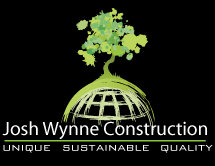Lotus on Orange
The lotus flower represents a symbol of fortune in Buddhism. It grows in muddy water, and it is this environment that gives forth the flower’s first and most literal meaning: rising and blooming above the murk to achieve enlightenment.
A building site was selected in an historic area just south of downtown Sarasota, known as Bungalow Heights. The site was burdened by a neglected ranch home with no architectural value. The home was beyond repair and, with its blue-tarped roof, had become a real eyesore for this cozy corner of town. The home was razed, with the majority of the building materials diverted to a recycling facility. The site was reborn.
The new residents had a vision for a warm, modern home that allowed them to take full advantage of our fantastic weather. They were interested in sound mitigation to compensate for the traffic sounds that are generated from an Orange Avenue frontage. Indoor health, energy and water conservation, durable material considerations and general sustainability were important design considerations from the beginning. After extensive interviews, the client selected their design and build team to create and execute their vision. Chris Leader, of Leader Design would lead the architectural process. Sawa Design was selected to help with the interiors. Michael Gilkey, of M.A. Gilkey Landscapes, was selected to design the outdoor spaces. Josh Wynne Construction was chosen to manage the budget during design, manage the sustainable design aspects and to build the new home.
Lotus on Orange was designed with consideration of the clients’ love of European Modern styling as well as their love of the warmth from the California style of modern homes. Tied to the demands of our local environment and our regional material selections, the resulting design bears a strong resemblance to the Sarasota School of Architecture style that defined the local vernacular in the 1950’s. The large expanses of carefully placed glass allow for natural day-lighting throughout the home while large sliders and casement glass allow for passive ventilation through the home. The views are centralized to the natural flower pond in the front-court as well as the pool and outdoor living areas to the rear. The roof integrated screen enclosure is reminiscent of earlier efforts by early architects during the Sarasota School movement.
The material palette is warm, simple, and is characterized by clean lines and strong geometry. Polished concrete floors were chosen for their durability, thermal massing effect, and their natural beauty. Cypress wood detailing, terrazzo tiles, and bamboo panels counter-balance the smooth white walls of the homes interior which serve to provide bouncing light and a frame work for viewing the outdoor spaces.
The landscape is 100% Florida friendly. It was carefully considered to provide the necessary screen-work in an infill lot such as this, while being sensitive to the single story scale of the home and the adjacent neighbors. There are three courtyards that are the critical adjuncts between the vertical architecture and the landscape architecture. The entry court welcomes you from the street frontage with a Koi and Lotus pond. A fountain provides a visible anchor and produces white noise to drown out the sounds of city life. Every visit starts with a walk across the floating pads in the Lotus pond. The rear court is the heart of the home. The “L” shaped design lives around and is open to this pool court with outdoor fireplace and kitchen area. To look west in this home is to lose your sense of place. The last courtyard is the most private. It is flanked by the master suite and is accessible only through the master bath. Glass walls, orchid walls and a thick tropical color garden complete the space.
